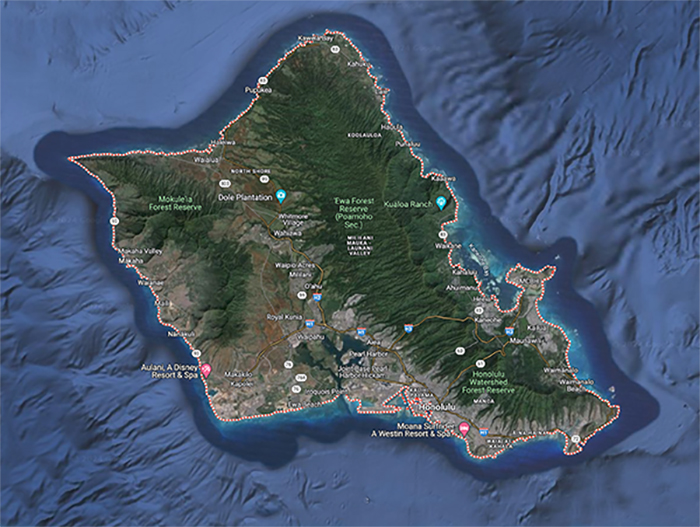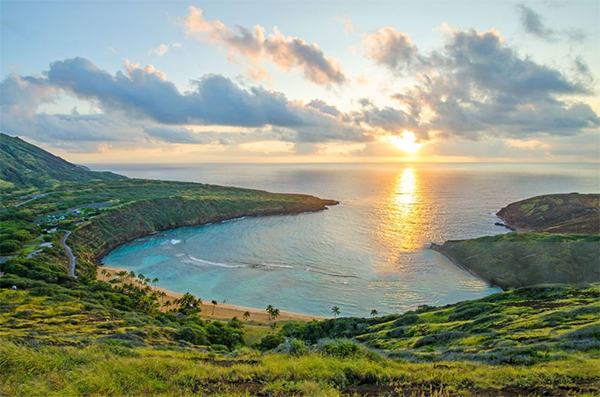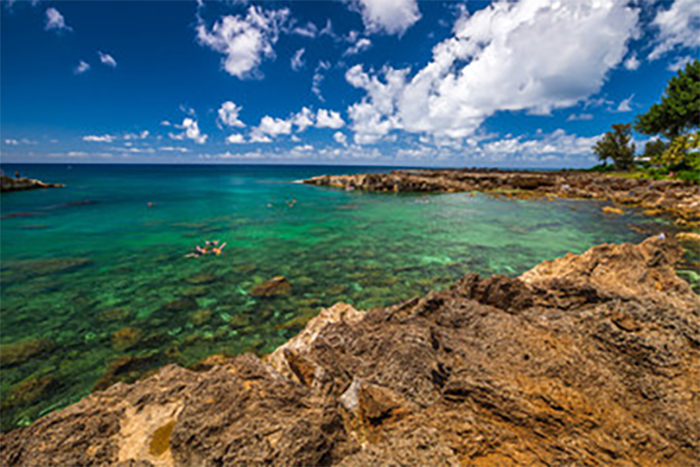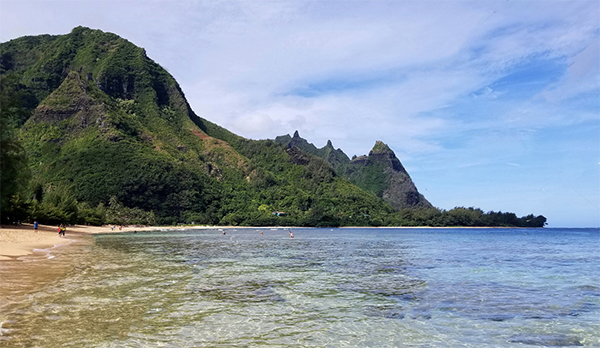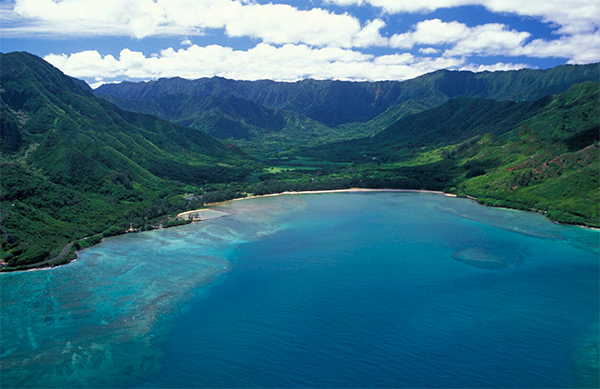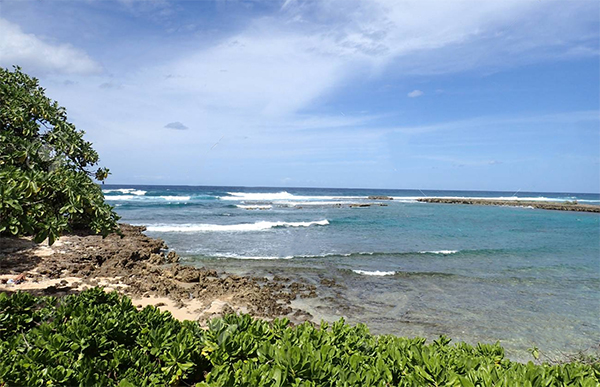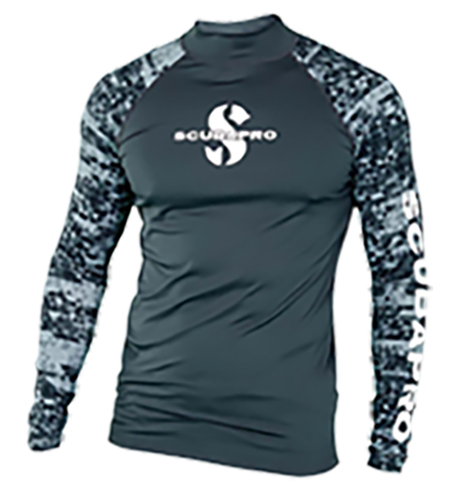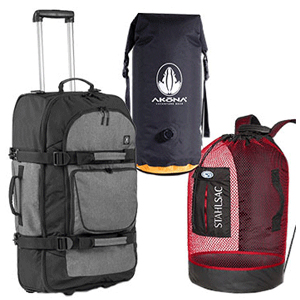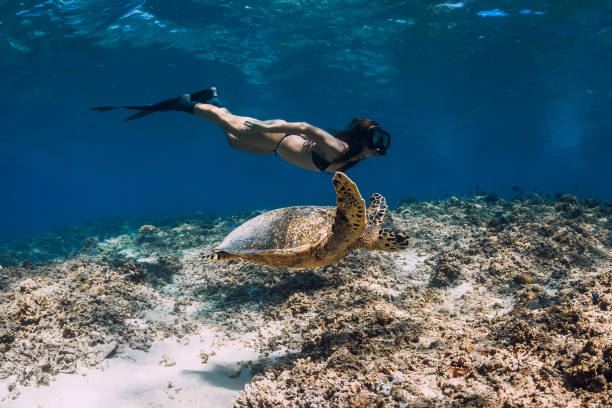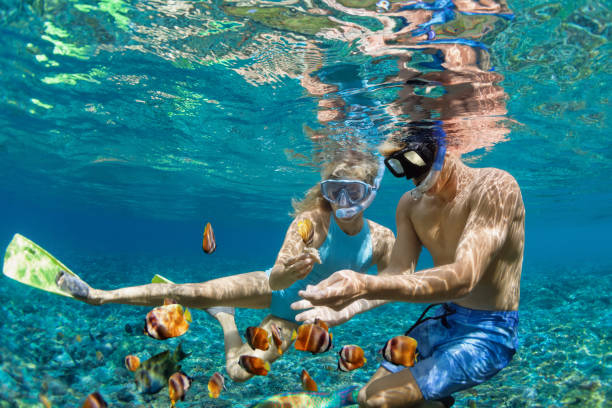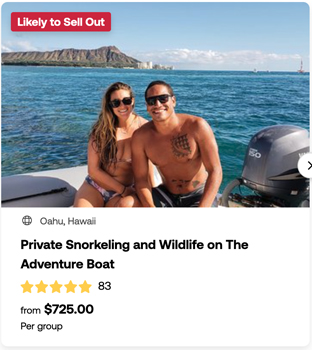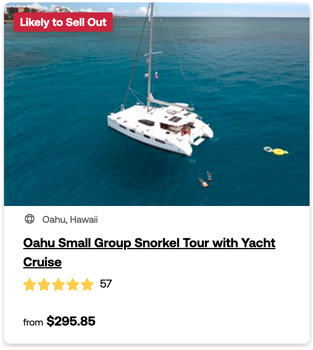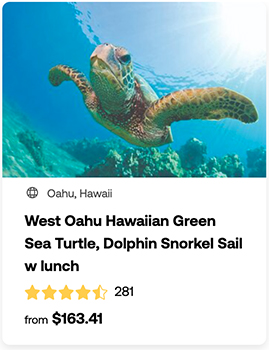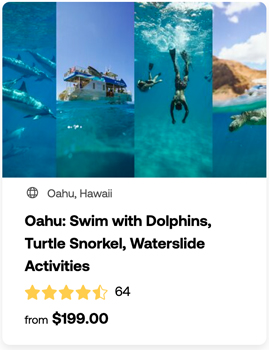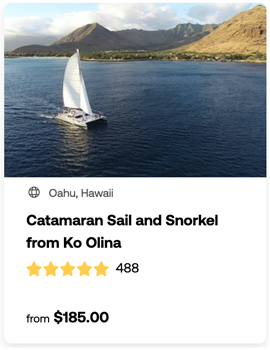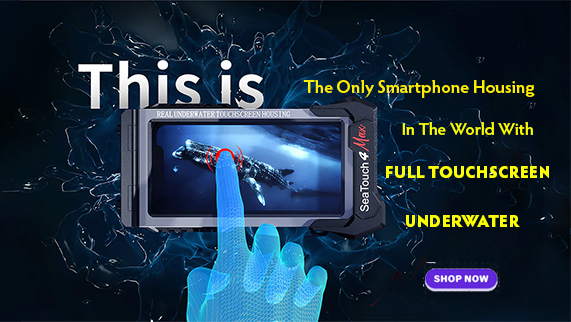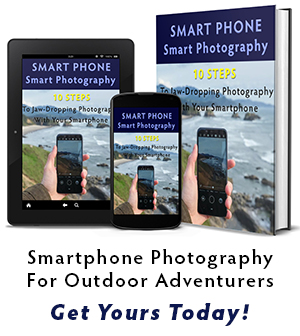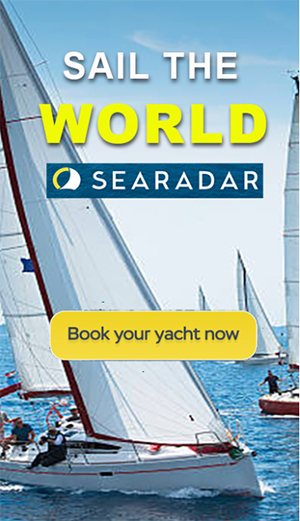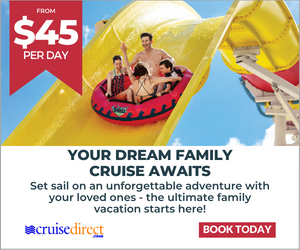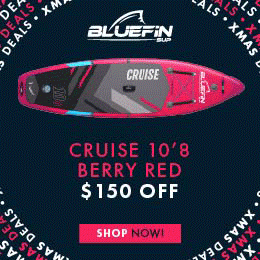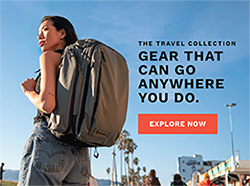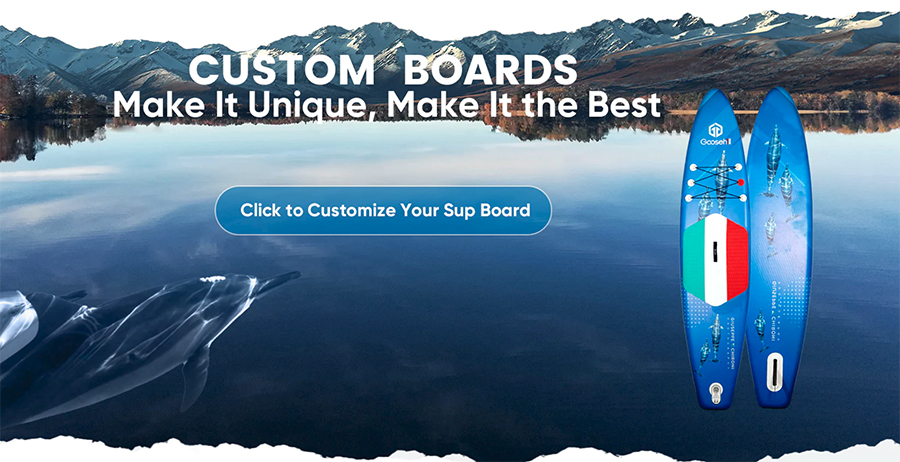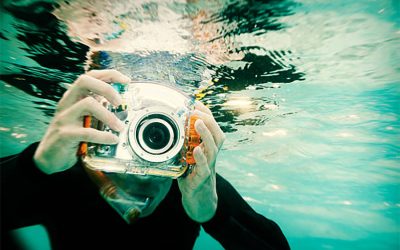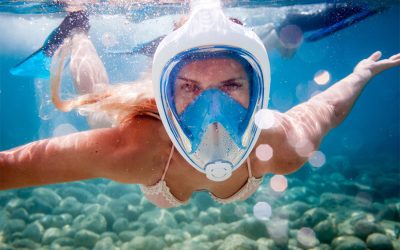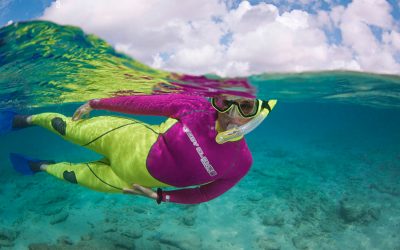Best Snorkeling In Oahu - Exploring Paradise Beneath the Waves
Welcome to the ultimate guide to the best snorkeling in Oahu, Hawaii’s most enchanting island paradise. With its crystal-clear waters, vibrant marine life, and stunning coral reefs, Oahu offers snorkelers an unparalleled underwater experience.
From the iconic Hanauma Bay to hidden gems like the Makapu’u Tide Pools, this article serves as your passport to exploring the island’s top snorkeling spots. Whether you’re a seasoned snorkeler or a first-time adventurer, join me as we dive into the azure depths and uncover the aquatic wonders that make Oahu a haven for underwater enthusiasts.
As we embark on this journey, I’ll equip you with essential tips for a safe and unforgettable snorkeling experience. From gearing up with the right equipment to respecting marine life and ecosystems, our guide ensures that every moment spent exploring Oahu’s underwater realm is filled with wonder and respect.
So, grab your snorkel gear and get ready to immerse yourself in the natural beauty and tranquility of the best snorkeling in Oahu
This site uses affiliate links which may earn a commission at no additional cost to you
Here's What You'll Learn About The Best Snorkeling In Oahu
In this article on the best snorkeling in Oahu you will embark on an immersive journey through the island’s most captivating underwater landscapes. You’ll discover a comprehensive guide to the finest snorkeling spots, each offering unique marine ecosystems and breathtaking encounters with colorful coral reefs and fascinating sea creatures.
Where Is The Best Snorkeling In Oahu?
1. Hanauma Bay
Hanauma Bay, a crescent-shaped haven on Oahu’s southeastern coast, is widely considered one of the best snorkeling spots in Hawaii. This partially submerged volcanic crater, formed over 32 million years ago, offers a protected bay teeming with vibrant marine life.
Description:
- Calm, clear waters ideal for beginner and experienced snorkelers.
- Crescent-shaped beach with a concession stand offering snorkel gear rentals and refreshments.
- Mandatory educational video about the bay’s ecosystem and responsible snorkeling practices.
- Designated underwater snorkeling areas with varying depths.
Marine Life:
- Over 450 species of colorful fish, including butterflyfish, triggerfish (Hawaii’s state fish!), angelfish, and parrotfish.
- Eels, octopus, and sea turtles are also frequent sightings.
- Healthy coral reefs teeming with life.
Important Information for Snorkelers:
- Reservations: Due to its popularity, reservations are required to access Hanauma Bay. Book online in advance to secure your spot.
- Facilities: Restrooms, showers, and a concession stand are available.
- Gear: Snorkel gear rentals are available, but bringing your own is recommended.
Rules and Regulations:
- Watch the mandatory educational video before entering the water.
- Respect the delicate ecosystem: don’t touch or stand on the coral reefs.
- Use reef-safe sunscreen to protect the marine life.
- Be mindful of other snorkelers and maintain buoyancy control.
Additional Tips:
- Arrive early, especially during peak season, to avoid crowds.
- Consider taking a guided snorkeling tour for a more in-depth experience.
- Pack comfortable clothes, sunscreen, a hat, and water.
- Relax and enjoy the underwater world!
By following these tips and information, you can ensure a safe and unforgettable snorkeling experience at Hanauma Bay, Oahu. Remember, responsible tourism goes a long way in preserving this natural wonder for generations to come.
2. Sharks Cove
Sharks Cove, nestled along Oahu’s North Shore, offers a unique snorkeling experience for those seeking an off-the-beaten-path adventure. While its name might sound intimidating, fear not! This cove is named for its resemblance to a shark from above, not for an abundance of these apex predators.
Description:
- Rocky cove with a protected bay and calm waters, ideal for beginner and intermediate snorkelers.
- Entry and exit points on both the east and west sides.
- The east side features shallow tide pools, perfect for exploring various marine life.
- The west side offers deeper waters with interesting rock formations and coral reefs.
Marine Life:
- Although Sharks Cove lacks extensive coral reefs, it boasts a vibrant population of fish due to the protected environment.
- Expect to see colorful reef fish like butterflyfish, tangs, and damselfish.
- Eels, octopus, and even the occasional sea turtle can be spotted here.
Important Information for Snorkelers:
- Conditions: Sharks Cove is best snorkeled during calm summer months (June-August) when waves are smaller and visibility is optimal. Winter months bring large waves that make snorkeling dangerous.
- Facilities: Sharks Cove is a public park with limited facilities. There are no restrooms, showers, or concession stands. Pack accordingly and plan to use facilities in nearby Haleiwa Town.
- Gear: Restrooms and showers are not available, so plan to change beforehand and rinse off after at another location. Bring your own snorkel gear for a better fit and hygiene.
- Parking: Parking is available on the roadside near the cove. Be mindful of street signs and parking restrictions.
- Safety: Sharks Cove is an unprotected shore break. There are no lifeguards on duty, so be aware of your surroundings, swim with a buddy, and stay within your limits.
Additional Tips:
- Arrive early to secure parking, especially on weekends and during peak season.
- Consider renting a wetsuit for added warmth and protection from the volcanic rock.
- Pack reef-safe sunscreen, snacks, and plenty of water.
- Be respectful of the environment and leave no trace behind. Take all your trash with you.
Sharks Cove offers a unique snorkeling experience with a relaxed atmosphere. By following these tips and information, you can have a safe and enjoyable underwater adventure at this Oahu gem.
Remember, responsible tourism goes a long way in preserving this beautiful spot for future generations.
3. Kaiona Beach Park
Kaiona Beach Park, situated on Oahu’s windward coast in Waimanalo, offers a delightful snorkeling experience for families and casual snorkelers. Unlike the structured environment of Hanauma Bay, Kaiona Beach provides a relaxed and scenic alternative.
Description:
- Long stretch of white sand beach with calm, clear waters ideal for beginner and young snorkelers.
- Fringed by a grassy area with picnic tables and restrooms, perfect for a relaxing beach day.
- The best snorkeling area is located on the right side (looking out to the ocean) near the low rock wall.
- Visibility can vary depending on water conditions, but on clear days, snorkeling can be quite rewarding.
Marine Life:
- While not as teeming with life as other Oahu snorkeling spots, Kaiona Beach offers encounters with colorful reef fish like butterflyfish, angelfish, and occasional schools of vibrant damselfish.
- Eels and octopus can sometimes be spotted amongst the rock formations.
- Green sea turtles are known to frequent the area, especially during the summer months. However, it’s important to observe them from a respectful distance.
Important Information for Snorkelers:
- Conditions: Snorkeling is best during calm summer months (May-September) when water clarity is optimal. Winter months can bring strong currents and rough waves, making snorkeling unsafe.
- Facilities: Kaiona Beach Park offers basic amenities including restrooms, showers, and picnic tables. However, there are no lifeguards on duty and no concession stands for snorkel gear rentals.
- Gear: It’s recommended to bring your own snorkel gear for a better fit and hygiene.
- Parking: Parking is available along the roadside near the beach. Be mindful of street signs and parking restrictions.
- Safety: Kaiona Beach is an open ocean environment. There are no lifeguards on duty, so be aware of your surroundings, swim with a buddy, and stay within your limits.
Additional Tips:
- Arrive early, especially on weekends and during peak season, to secure a good parking spot.
- Consider bringing a beach umbrella for shade, as there are limited shaded areas near the water.
- Pack
- reef-safe sunscreen, snacks, and plenty of water.
- Be respectful of the environment and leave no trace behind. Take all your trash with you.
Kaiona Beach offers a laid-back snorkeling experience perfect for those seeking a scenic and calm underwater adventure. By following these tips and information, you can have a safe and enjoyable time exploring the marine life at this Oahu gem.
Remember, responsible tourism goes a long way in preserving this beautiful beach and its underwater world.
4. Makua Beach
Makua Beach, also known as Tunnels Beach, located on Oahu’s west coast, offers a secluded and adventurous snorkeling experience for experienced swimmers and those seeking a taste of Hawaiian wilderness.
Description:
- Rugged coastline with golden sand beach and lava rock formations.
- Entry and exit require some effort, involving a short walk over lava rock and potentially navigating small tide pools.
- Snorkeling areas are located on either side of the large rock outcropping, Pohaku Kula’ila’i.
- The left side (facing the ocean) offers calmer waters and coral reefs teeming with life.
- The right side boasts dramatic lava rock formations and deeper waters with stronger currents.
Marine Life:
- Makua Beach boasts a rich diversity of marine life due to the healthy coral reefs and varied underwater terrain.
- Expect to see colorful reef fish like butterflyfish, tangs, and wrasse.
- Eels, octopus, and even the occasional manta ray or Hawaiian spinner dolphins can be spotted here.
- Sea turtles are known to frequent the area, particularly during the summer months. Remember to observe them from a respectful distance.
Important Information for Snorkeling:
- Conditions: Makua Beach is best snorkeled during calm summer months (May-September) with minimal waves and good visibility. Winter months bring strong currents and large waves, making snorkeling dangerous. Always check the surf report before heading out.
- Facilities: Makua Beach is a remote location with no facilities. There are no restrooms, showers, lifeguards, or concession stands. Be prepared to come self-sufficient with all necessary gear, food, water, and waste disposal.
- Gear: Due to the remote location, bringing your own snorkel gear is essential. Wearing water shoes for navigating the lava rock is highly recommended.
- Parking: Limited parking is available on the roadside near the beach. Be mindful of designated parking areas and avoid blocking traffic.
- Safety: Makua Beach is an open ocean environment with strong currents and occasional rip tides. There are no lifeguards on duty. Only experienced snorkelers comfortable in strong currents should attempt snorkeling here. Always swim with a buddy and stay within your limits.
Additional Tips:
- Arrive early to secure parking, especially on weekends and during peak season.
- Pack reef-safe sunscreen, a sun hat, snacks, plenty of water, and a waterproof bag for your belongings.
- Be mindful of the environment and leave no trace behind. Pack out all your trash.
- Consider bringing a waterproof phone case to capture underwater photos.
Makua Beach offers a unique and adventurous snorkeling experience for those seeking a challenge and a chance to witness the wonders of Oahu’s underwater world.
However, it’s important to be prepared and prioritize safety due to the remote location and strong currents.
Remember, responsible tourism goes a long way in preserving this beautiful beach and its marine life.
5. Kahana Bay
Kahana Bay Beach Park, nestled along Oahu’s windward coast between Waikiki and the North Shore, offers a unique snorkeling experience. While the underwater world might not be as vibrant as other Oahu spots, Kahana Bay’s charm lies in its scenic beauty and relaxed atmosphere.
Description:
- Picturesque beach with a crescent-shaped bay and calm waters, ideal for beginner snorkelers and families with young children.
- Lush green mountains framing the backdrop create a postcard-perfect scene.
- Protected by a shallow reef, the bay offers a safe and calm environment for exploring.
- Snorkeling areas are scattered throughout the bay, with some spots offering glimpses of coral reefs and rock formations.
Marine Life:
- Unlike Oahu’s coral reef hotspots, Kahana Bay’s marine life is more modest.
- Expect to see colorful reef fish like butterflyfish, damselfish, and the occasional tang.
- Eels and octopus might be spotted hiding amongst the rocks.
- Sea turtles are known to visit the bay occasionally, but sightings are not guaranteed. Admire them from a respectful distance if encountered.
Important Information for Snorkeling:
- Conditions: Kahana Bay is best snorkeled during calm summer months (May-September) when water clarity is optimal. Winter months can bring stronger currents and choppier waters, making snorkeling less ideal.
- Facilities: Kahana Bay Beach Park offers basic amenities like restrooms and showers. However, there are no lifeguards on duty and no concession stands for snorkel gear rentals.
- Gear: Bringing your own snorkel gear is recommended for a better fit and hygiene.
- Parking: Two designated parking areas are available, with the northern lot typically busier. Arrive early, especially on weekends and during peak season, to secure a spot.
- Freshwater Showers: Be aware that the showers at Kahana Bay sometimes have limited freshwater availability. Pack a towel and consider bringing a small amount of freshwater for rinsing off after snorkeling.
Additional Tips:
- The nearby Kahana River empties into the bay. After heavy rain, the water can become murky. Aim for your visit during sunny stretches for the best visibility.
- Pack reef-safe sunscreen, snacks, plenty of water, and a beach umbrella for shade, as there are limited shaded areas.
- Be respectful of the environment and leave no trace behind. Pack out all your trash.
Kahana Bay’s Twist:
Kahana Bay offers more than just snorkeling. Keep an eye out for Hawaiian green sea turtles basking on the beach. Be sure to maintain a safe distance and avoid disturbing them.
Overall:
Kahana Bay provides a scenic and relaxing snorkeling experience perfect for families and those seeking a calmer introduction to Oahu’s underwater world. By following these tips and information, you can have a pleasant and enjoyable time exploring this beautiful Oahu gem.
Remember, responsible tourism goes a long way in preserving the beauty of Kahana Bay for future generations.
6. Three Tables Beach
Three Tables Beach, located on Oahu’s North Shore near Waimea Bay, offers a unique and adventurous snorkeling experience for experienced snorkelers and those seeking an off-the-beaten-path adventure.
This remote beach is known for its three distinct flat rock platforms – its namesake “three tables” – that jut out into the ocean.
Description:
- Rugged and scenic coastline with a sandy beach and three large, flat lava rock platforms.
- Entry and exit require navigating the lava rock platforms, which can be slippery, especially when wet. Water shoes are highly recommended.
- Snorkeling is best done on the calmer sides of the platforms during high tide. The waves can be strong and entry/exit difficult during low tide.
- Explore the underwater world around the lava rock formations and coral reefs teeming with life.
Marine Life:
- Three Tables Beach boasts a vibrant population of marine life due to the healthy coral reefs and varied underwater terrain.
- Expect to see a wider variety of colorful reef fish compared to other Oahu shore snorkeling spots, including butterflyfish, tangs, wrasse, and even the occasional moray eel.
- Octopus, colorful nudibranchs, and even manta rays or Hawaiian spinner dolphins can sometimes be spotted here.
- Sea turtles are known to frequent the area, particularly during the summer months. Remember to observe them from a safe distance.
Important Information for Snorkeling:
- Conditions: Three Tables Beach is best snorkeled during calm summer months (May-September) with minimal waves and good visibility. Winter months bring strong currents, large waves, and potentially dangerous shore breaks. Always check the surf report before heading out.
- Facilities: Three Tables Beach is a remote location with no facilities. There are no restrooms, showers, lifeguards, or concession stands. Be prepared to come self-sufficient with all necessary gear, food, water, and waste disposal.
- Gear: Due to the remote location, bringing your own snorkel gear is essential. Wearing water shoes for navigating the lava rock platforms is crucial for safety.
- Parking: Limited parking is available on the roadside near the beach. Be mindful of designated parking areas and avoid blocking traffic.
- Safety: Three Tables Beach is an open ocean environment with strong currents, occasional rip tides, and a rocky shore entry/exit. There are no lifeguards on duty. Only experienced snorkelers comfortable in strong currents and navigating waves should attempt snorkeling here. Always swim with a buddy and stay within your limits.
Additional Tips:
- Arrive early, especially on weekends and during peak season, to secure parking.
- Pack reef-safe sunscreen, a sun hat, snacks, plenty of water, and a waterproof bag for your belongings.
- Be mindful of the environment and leave no trace behind. Pack out all your trash.
- Consider bringing a waterproof phone case to capture underwater photos.
Overall:
Three Tables Beach offers a challenging but rewarding snorkeling experience for those seeking adventure and a chance to explore a vibrant underwater world. However, it’s important to be prepared, prioritize safety due to the remote location and strong currents, and be an experienced snorkeler.
Remember, responsible tourism goes a long way in preserving this beautiful beach and its marine life.
7. Kuilima Cove:
Kuilima Bay, situated on Oahu’s southwest shore within the Ko Olina Resort area, offers a convenient and enjoyable snorkeling experience with a resort twist.
This protected bay boasts calm waters and interesting underwater features, making it ideal for families and beginner snorkelers.
Description:
- Crescent-shaped bay with a sandy beach and calm, clear waters perfect for beginner snorkelers and families with young children.
- Part of a resort area, offering amenities like restrooms, showers, and nearby restaurants.
- Designated snorkeling areas marked by buoys, ensuring a safe and enjoyable experience.
- Underwater rock formations and man-made structures (like rock walls) create an interesting seascape for exploring.
Marine Life:
- While not teeming with the most diverse marine life compared to other Oahu spots, Kuilima Bay offers a pleasant underwater encounter.
- Expect to see colorful reef fish like butterflyfish, angelfish, and damselfish.
- Eels, octopus, and even the occasional sea turtle might be spotted here.
Important Information for Snorkeling:
-
Conditions: Kuilima Bay is ideal for snorkeling year-round due to its protected location. However, water clarity can be affected by occasional winter swells.
-
Facilities: Restrooms, showers, and changing facilities are available within the Ko Olina Resort area (usage fees may apply depending on location). Several restaurants are also located nearby.
-
Gear: Snorkel gear rentals are available at nearby shops or through resort activities. You can also bring your own for a better fit and hygiene.
-
Fees: Some areas within the Ko Olina Resort may charge a resort fee for access to the beach and facilities. Check with your accommodation or the resort management for details.
-
Safety: Lifeguards are typically present within the Ko Olina Resort area during peak hours. However, always swim with a buddy and stay within your limits.
Additional Tips:
- While the resort offers amenities, consider packing snacks and drinks, especially if you have a long day planned.
- Beach chairs and umbrellas are available for rent within the resort area.
- Explore the tide pools located near the edges of the bay for interesting critters like crabs and hermit crabs.
- Take a guided snorkeling tour for a more in-depth exploration of the bay and additional safety measures.
Kuilima Bay’s Twist:
Unlike other Oahu snorkeling spots, Kuilima Bay offers the convenience of a resort setting. After your snorkeling adventure, relax on the beach, grab a bite to eat, or enjoy other resort amenities.
Overall:
Kuilima Bay provides a relaxing and accessible snorkeling experience perfect for families and those seeking a hassle-free introduction to Oahu’s underwater world. With amenities, calm waters, and interesting underwater features, Kuilima Bay offers a unique twist on snorkeling in Oahu.
Remember, even within a resort area, practicing responsible tourism goes a long way in preserving the marine life.
8. Makapu'u Tide Pools
The Makapu’u Tide Pools, located along Oahu’s southeastern coast at the base of the Makapu’u Point Lighthouse Trail, offer a unique tide pool experience that can be enjoyed by both tide poolers and adventurous snorkelers. However, it’s important to understand this is not a traditional snorkeling spot and prioritizes safety due to the exposed location and rocky terrain.
Description:
- Series of tide pools carved into the lava rock along the rugged coastline.
- Pools vary in size and depth, with some shallow enough for wading and others deeper and suitable for snorkeling (during high tide with caution).
- Breathtaking scenery with panoramic views of the Pacific Ocean and coastline.
- Home to a variety of tide pool creatures exposed during low tide.
Marine Life:
- Tide pool residents include colorful tide pool fish, sea stars, hermit crabs, sea urchins, limpets, and tide pool shrimps.
- During high tide (with caution), snorkelers might encounter a limited variety of fish compared to other Oahu snorkeling spots.
Important Information:
- Conditions: The Makapu’u Tide Pools are best explored during low tide for tide pooling and very high tide (use extreme caution) for limited snorkeling. Check tide tables before your visit.
- Facilities: There are no restrooms, showers, lifeguards, or concession stands at the Makapu’u Tide Pools. Come prepared with everything you need, including water shoes for navigating the rocky terrain.
- Gear: Snorkel gear is not essential, but can be used with extreme caution during high tide in deeper pools. However, prioritize tide pooling and exploring the exposed marine life during low tide.
- Safety: The Makapu’u Tide Pools are an exposed location with strong waves and currents, especially during high tide. Never swim alone and be extremely cautious if attempting to snorkel. The focus should be on tide pooling during low tide when the water is calm.
- Respect the Environment: The tide pools are a delicate ecosystem. Be mindful of your movements, avoid touching or stepping on tide pool creatures, and leave no trace behind. Take all your trash with you.
Additional Tips:
- Wear sturdy shoes with good grip for navigating the slippery rocks.
- Pack reef-safe sunscreen, a hat, and plenty of water, especially if you plan to spend extended time tide pooling.
- Explore the tide pools during the first few hours of low tide when the exposed creatures are most active.
- Be aware of the potential for sneaker waves that can sweep you off the rocks.
- This location is not recommended for young children or weak swimmers due to the uneven terrain and strong waves.
Overall:
The Makapu’u Tide Pools offer a unique opportunity to explore a vibrant intertidal ecosystem. While snorkeling is an option during high tide with extreme caution, prioritize safety and focus on tide pooling during low tide for the most rewarding experience.
Remember, responsible tourism goes a long way in preserving this delicate tide pool habitat.
9. Waimea Bay
Waimea Bay, a world-famous surfing spot on Oahu’s North Shore, offers a thrilling seasonal snorkeling experience for experienced swimmers and those who enjoy dramatic scenery.
While the underwater world isn’t as abundant as other Oahu spots, the chance to snorkel alongside crashing waves and witness powerful ocean forces creates a unique adventure.
Description:
- Wide, crescent-shaped bay with a sandy beach and powerful waves during winter months.
- Calmer waters and exposed rock formations on either side of the bay during summer months, offering areas suitable for snorkeling.
- Snorkeling is best done within designated areas near the rocky edges, away from the strong currents in the center of the bay.
- Breathtaking views of the North Shore coastline and a chance to witness surfers riding impressive waves (during winter).
Marine Life:
- Due to the sandy bottom and strong currents, the variety of fish is limited compared to other Oahu snorkeling spots.
- Expect to see some colorful reef fish like butterflyfish and tangs, as well as eels and octopus hiding amongst the rocks.
- Spotting sea turtles is possible, but not guaranteed. Remember to observe them from a safe distance.
Important Information for Snorkeling:
- Conditions: Waimea Bay is best for snorkeling during calm summer months (May-September) when waves are smaller and visibility is optimal. Winter months bring large waves and strong currents, making snorkeling extremely dangerous. Always check the surf report before heading out.
- Facilities: Basic restrooms and showers are available near the parking lot. However, there are no lifeguards on duty, no concession stands for snorkel gear rentals, and limited shade.
- Gear: Bringing your own snorkel gear is recommended for a better fit and hygiene. Water shoes are also helpful for navigating the rocky areas.
- Parking: Parking is available on the roadside near the beach. Be mindful of designated parking areas and avoid blocking traffic.
- Safety: Waimea Bay is an open ocean environment with strong currents and occasional rip tides, especially during winter. There are no lifeguards on duty. Only very experienced snorkelers comfortable in strong currents and waves should attempt snorkeling here. Always swim with a buddy and stay within your limits.
Additional Tips:
- Arrive early, especially on weekends and during peak season, to secure parking.
- Pack reef-safe sunscreen, a hat, plenty of water, and snacks as there are limited options nearby.
- Be aware of your surroundings and the powerful waves, especially if snorkeling during summer months. Stay within designated areas and avoid venturing into the center of the bay with strong currents.
- Consider taking a guided snorkeling tour for a more in-depth exploration with a knowledgeable guide who can navigate the currents safely.
Overall:
Waimea Bay offers a unique and adrenaline-filled snorkeling experience for those seeking adventure and a chance to witness the majesty of the North Shore waves.
However, it’s crucial to prioritize safety due to the strong currents and wave action. Only experienced snorkelers comfortable in such conditions should attempt it.
Remember, responsible tourism goes a long way in respecting the power of the ocean and ensuring your safety.
Gear Up for Adventure: Must-Have Essentials for Snorkeling Success
Having the right essential gear for snorkeling is paramount for a safe, enjoyable, and memorable underwater experience. A well-fitted mask ensures clear vision and prevents leaks, while a quality snorkel allows for effortless breathing at the surface.
Fins provide propulsion, enhancing mobility and conserving energy during exploration. Additionally, protective gear like rash guards or wetsuits shield against sunburn and abrasions, ensuring comfort throughout the adventure.
Investing in the proper equipment not only enhances comfort and safety but also opens doors to discovering the mesmerizing beauty beneath the waves.
Here’s a checklist of essential snorkeling gear:
- Mask: Choose a mask that fits snugly on your face and provides a clear view.
- Fins: Fins will help you propel yourself through the water and conserve energy.
- Snorkel: A snorkel allows you to breathe while keeping your face submerged in the water.
- Reef-safe Sunscreen: Look for sunscreen labeled “reef-safe” or “oxybenzone-free” to protect coral reefs from harmful chemicals.
- Wetsuit (Optional): A wetsuit can help you stay warm in the water, especially if you’ll be snorkeling for long periods.
Whether you’re a beginner or a seasoned snorkeler, having the right gear sets the stage for unforgettable aquatic adventures.
Special Product Feature - Seaview 180 V3 Full Face Snorkel Mask
Snorkeling Gear - Renting vs. Owning
Here’s a breakdown of the pros and cons of owning your own snorkeling gear versus renting:
Owning Your Own Snorkeling Gear:
Pros:
1. Personalization: You can choose gear that fits you perfectly, ensuring maximum comfort and safety.
2. Familiarity: Owning your gear means you’re familiar with its condition, making it easier to use and maintain.
3. Convenience: No need to wait in lines or deal with potential shortages during peak rental times.
4. Cost-Effective Over Time: If you snorkel frequently, owning your gear can be more cost-effective in the long run compared to repeated rental fees.
5. Availability: You have your gear whenever you want, whether it’s for a last-minute trip or a spontaneous snorkeling adventure.
Cons:
1. Initial Investment: Purchasing snorkeling gear can be expensive upfront, especially if you opt for higher-quality equipment.
2. Storage: You’ll need space to store your gear when not in use, which may be a concern for those with limited storage space.
3. Maintenance: Owning your gear means you’re responsible for its upkeep, including cleaning, maintenance, and occasional repairs.
Renting Snorkeling Gear:
Pros:
1. Affordability: Renting gear is often cheaper upfront, making it a more budget-friendly option for occasional snorkelers.
2. No Maintenance Required: You don’t have to worry about cleaning or maintaining the gear; simply return it after use.
3. Variety: Rental shops typically offer a variety of gear, allowing you to try different brands or models before committing to a purchase.
4. Travel Convenience: If you’re traveling, renting gear eliminates the need to transport your own, saving luggage space and weight.
5. No Storage Hassles: You don’t have to worry about finding storage space for your gear when you’re not using it.
Cons:
1. Fit and Comfort: Rental gear may not fit perfectly, leading to discomfort or leaks while snorkeling.
2. Availability: During peak seasons or at popular snorkeling destinations, rental gear may be in high demand, leading to shortages or long wait times.
3. Cost Over Time: For frequent snorkelers, rental fees can add up and eventually surpass the cost of owning your gear.
4. Hygiene Concerns: While rental gear is usually cleaned between uses, some people may have hygiene concerns about using equipment that has been worn by others.
5. Limited Availability: Rental shops may not always have the specific gear you prefer, such as certain mask styles or sizes, fins, or snorkels.
Ultimately, the decision between owning your own snorkeling gear and renting depends on factors such as your budget, frequency of snorkeling, personal preferences, and travel plans.
Best Snorkeling In Oahu - Tips For Safe Snorkeling
Oahu, Hawaii, with its crystal-clear waters and vibrant marine life, offer an unparalleled snorkeling experience. However, like any water activity, snorkeling requires preparation and awareness to ensure a safe and enjoyable adventure.
Whether you’re a novice or experienced snorkeler, these tips will help you navigate the waters of Oahu with confidence.
1. Choose the Right Location: Selecting the right snorkeling spot is crucial for a safe and rewarding experience. The island of Oahu boast numerous snorkeling sites, each with its unique characteristics. Research the locations beforehand to determine their suitability for your skill level and interests.
2. Check Weather Conditions: Before heading out, always check the weather forecast and current sea conditions. Snorkeling in rough seas or during inclement weather can be dangerous. Strong currents and high winds may impair visibility and make it challenging to navigate. Plan your excursion on days with calm seas and clear skies for optimal safety and enjoyment.
3. Use Proper Equipment: Invest in high-quality snorkeling gear to enhance your safety and comfort in the water. A well-fitting mask, snorkel, and fins are essential for an effortless and enjoyable experience. Ensure your equipment is in good condition and free from defects before each use.
Additionally, consider wearing a snorkeling vest or flotation device for added buoyancy, especially if you’re a beginner or not a strong swimmer.
4. Buddy Up: Never snorkel alone. Always swim with a buddy or in a group, preferably someone with snorkeling experience. Having a companion provides an extra layer of safety in case of emergencies and allows you to watch out for each other while exploring the underwater world.
5. Practice Proper Technique: Before diving into the water, familiarize yourself with proper snorkeling techniques. Practice breathing through the snorkel while keeping your face submerged in the water.
Avoid hyperventilating or holding your breath, as it can lead to shallow water blackout. Relax and take slow, deep breaths to conserve energy and prolong your time underwater.
6. Respect Marine Life: The Florida Keys are home to a diverse array of marine species, from colorful fish to majestic corals. Treat the underwater ecosystem with respect and avoid touching or harassing marine life.
Keep a safe distance from coral reefs to prevent accidental damage. Remember, you’re a guest in their habitat, so observe and admire from a respectful distance.
7. Stay Hydrated and Protected: Snorkeling under the Florida sun can be dehydrating, so remember to drink plenty of water before and after your adventure. Apply a reef-safe sunscreen to protect your skin from harmful UV rays, and consider wearing a rash guard or wetsuit for additional sun protection and warmth.
8. Be Aware of Potential Hazards: While snorkeling in Oahu is generally safe, it’s essential to be aware of potential hazards, such as jellyfish, sharp coral, and strong currents.
Pay attention to warning signs and listen to local recommendations regarding water conditions. If you encounter any dangerous marine life or feel unsafe in the water, calmly return to shore and seek assistance if needed.
Snorkeling in Oahu offers an unforgettable opportunity to explore the beauty of the underwater world. By following these tips and practicing caution, you can ensure a safe and memorable snorkeling experience for yourself and your companions.
So don your gear, dive into the azure waters, and immerse yourself in the captivating wonders of the Oahu, Hawaii marine paradise.
Best Snorkeling In Oahu FAQ
1. What are the best snorkeling spots in Oahu?
Oahu offers several excellent snorkeling spots, including Hanauma Bay, Shark’s Cove, Kaiona Beach Park, and Electric Beach.
2. Is snorkeling suitable for beginners in Oahu?
Yes, Oahu has snorkeling spots suitable for beginners, such as Waikiki Beach and Kuilima Cove. These locations offer calm waters and abundant marine life, perfect for those new to snorkeling.
3. What is the best time of year for snorkeling in Oahu?
The best time for snorkeling in Oahu is during the summer months, from May to September, when the water is warm and the visibility is typically excellent. However, snorkeling can be enjoyed year-round in Oahu.
4. Are there any safety tips for snorkeling in Oahu?
Yes, it’s essential to follow safety guidelines while snorkeling in Oahu. Always snorkel with a buddy, avoid touching or stepping on coral, wear sunscreen to protect your skin from the sun, and be aware of ocean currents and wave conditions.
5. What marine life can be seen while snorkeling in Oahu?
Snorkelers in Oahu can encounter a diverse range of marine life, including colorful tropical fish, sea turtles, octopuses, eels, and occasionally dolphins and Hawaiian monk seals.
6. Are there snorkeling tours available in Oahu?
Yes, there are numerous snorkeling tour operators in Oahu that offer guided snorkeling excursions to popular spots such as Turtle Canyon and the North Shore. These tours often provide equipment rental and knowledgeable guides.
7. Can I rent snorkeling gear in Oahu?
Yes, snorkeling gear is readily available for rent at various shops and beach rental kiosks across Oahu. Rental options typically include snorkels, masks, fins, and even underwater cameras.
8. Are there any restrictions or regulations for snorkeling in Oahu?
Yes, some snorkeling areas in Oahu may have regulations in place to protect the marine environment, such as restrictions on feeding fish or touching coral. It’s essential to respect these rules to help preserve Oahu’s delicate marine ecosystem.
9. What should I bring with me for a snorkeling trip in Oahu?
It’s recommended to bring essentials such as sunscreen, a reusable water bottle, a towel, and a rash guard or swim shirt for sun protection. Additionally, don’t forget your snorkeling gear, including a mask, snorkel, and fins.
10. Are there family-friendly snorkeling spots in Oahu?
Yes, Oahu offers several family-friendly snorkeling spots with calm, shallow waters and easy access, such as Pokai Bay and Hanauma Bay. These locations are perfect for families with children who want to explore the underwater world together.
Check Out These Amazing Excursions On Oahu
Planning Your Oahu Snorkeling Adventure - Flights And Accommodations
Related Articles
Bonaire Snorkeling Adventures: A Snorkeler’s Complete Guide
Best Snorkeling Florida Keys: Dive Into Paradise With These Top Spots
Top Paddle Board Brands: Choosing The Best Standup Paddleboard
13 Best Scuba Gear Packages: Beginner To Advanced
Best Scuba Diving In Hawaii: Your Complete Guide To Paradise
Scuba Diving St.Thomas: Your Ultimate Guide To Underwater Exploration
Check Out Related Posts
Best Scuba Diving Camera For Beginners: The Top Picks For 2024
Selecting the best scuba diving camera for beginners is crucial as it can significantly enhance their underwater experience and immortalize unforgettable moments beneath the surface. These cameras enable divers to capture the awe-inspiring beauty of vibrant marine...
7 Best Full Face Snorkel Masks for Every Adventurer
Gazing at the wonders of the underwater world is an incredible experience, but traditional snorkel gear can sometimes get in the way. If you're looking to explore the reef with ease and maximum comfort, then a full face snorkel mask might be for you. These innovative...
Bonaire Snorkeling Adventures: A Snorkler’s Complete Guide
Bonaire beckons snorkelers to explore its enchanting underwater world, making it a premier destination for those seeking unparalleled experiences beneath the waves. With its fringing coral reefs, protected marine parks, and abundant marine life, Bonaire snorkeling...

